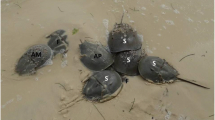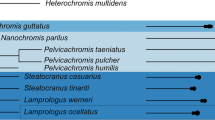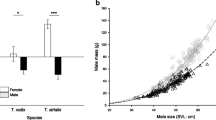Abstract
Sperm competition is a well-recognised agent in the evolution of sperm and ejaculate structure, as well as variation in female quality. Models of the evolution of ejaculate expenditure predict that male body condition, female fecundity and the risk and intensity of sperm competition may be the ultimate factors shaping optimal ejaculate size. We investigated sperm allocation in Austropotamobius italicus, a freshwater crayfish exhibiting a coercive mating system and external fertilisation, in relation to male and female traits and copulation behaviour under laboratory conditions. We found that mating males were sensitive to female size and produced larger ejaculates when mating with larger females, which were more fecund in terms of number of eggs produced. We found no evidence for female egg production being sperm-limited, as the number of eggs was not dependent on male sperm expenditure. Copulation duration and number of ejaculations reliably predicted the amount of sperm transferred, and both these behavioural measures positively covaried with female body size. These results indicate that male freshwater crayfish can modulate their sperm expenditure in accordance with cues that indicate female fecundity. In addition, a novel finding that emerged from this study is the decrease in sperm expenditure with male body size, which may either suggest that large, old male crayfish are better able than small males to economise sperm at a given mating to perform multiple matings during a reproductive season, or that they experience senescence of their reproductive performance.


Similar content being viewed by others

References
Acquistapace P, Aquiloni L, Hazlett BA, Gherardi F (2002) Multimodal communication in crayfish: sex recognition during mate search by male Austropotamobius pallipes. Can J Zool 80:2041–2045
Annala JH, Bycroft BL (1987) Fecundity in the New Zealand red rock lobster, Jasus edwardsii. N Z J Mar Freshwat Res 21:591–597
Arak A (1988) Sexual dimorphism in body size: a model and a test. Evolution 43:820–825
Bateman AJ (1948) Intra-sexual selection in Drosophila. Heredity 2:349–368
Bissoondath CJ, Wiklund C (1996) Effect of male mating history and body size on ejaculate size and quality in two polyandrous butterflies, Pieris pieris and Pieris rapae (Lepidoptera; Pieridae). Funct Ecol 10:457–464
Bonduriansky R (2001) The evolution of male mate choice in insects: a synthesis of ideas and evidence. Biol Rev 76:305–339
Brewis JM, Bowler K (1985) A study of reproductive females of the freshwater crayfish Austropotamobius pallipes. Hydrobiology 121:145–149
Ceballos-Vázquez BP, Rosas C, Racotta IS (2003) Sperm quality in relation to age and weight of white shrimp Litopenaeus vannamei. Aquaculture 228:141–151
Cordero A, Miller PL (1992) Sperm transfer, displacement and precedence in Ischnura graellsii (Odonata, Coenagrionidae). Behav Ecol Sociobiol 30:261–267
Chubb CF (1994) Reproductive biology: issues for management. In: Phillips BF, Cobb JS, Kittaka J (eds) Spiny lobster management: current situation and perspectives. Blackwell, Oxford, UK, pp 181–212
Crawley MJ (1993) GLIM for ecologists. Blackwell, Oxford, UK
Dewsbury DA (1982) Ejaculate cost and male choice. Am Nat 119:601–610
Dick JTA, Elwood RW (1989) The causal and functional organization of mating behaviour in Gammarus pulex (Amphipoda). Behav Processes 20:111–123
Evans JP, Magurran AE (1999) Male mating behaviour and sperm production characteristics under varying sperm competition risk in guppies. Anim Behav 58:1001–1006
Evans JP, Pierotti M, Pilastro A (2003) Male mating behavior and ejaculate expenditure under sperm competition risk in the eastern mosquitofish. Behav Ecol 14:268–273
Furrer SC (2004) Untersuchungen des Partnerwahlverhaltens beim Edel- und Galizierkrebs sowie der Life History beim Steinkrebs. Ph. D. thesis, University of Zürich
Gage MJG (1998) Influence of sex, size and symmetry on ejaculate expenditure in a moth. Behav Ecol 9:592–597
Gage MJG, Baker RR (1991) Ejaculate size varies with socio-sexual situation in an insect. Ecol Entomol 16:331–337
Gage MJG, Barnard CJ (1996) Male crickets increase sperm number in relation to competition and female size. Behav Ecol Sociobiol 38:227–237
Gage MJG, Cook PA (1994) Sperm size or numbers? Effect of nutritional stress on eupyrene and apyrene sperm production strategies in the moth Plodia interpunctella (Lepidoptera: Pyralidae). Funct Ecol 8:594–599
Galeotti P, Rubolini D, Fea G, Ghia D, Nardi PA, Gherardi F, Fasola M (2005) Female freshwater crayfish adjust egg and clutch size in relation to multiple male traits. Proc R Soc Lond B (in press)
George RW (2005) Comparative morphology and evolution of the reproductive structures in spiny lobsters, Panulirus. New Zeal J Mar Fresh 39:493–501
Gherardi F, Villanelli F, Dardi P (1997) Behavioral ecology of the white-clawed crayfish Austropotamobius pallipes in a Tuscan stream: preliminary results. Freshwater Crayfish 11:182–193
Gherardi F, Renai B, Galeotti P, Rubolini D (2005) Nonrandom mating, mate choice, and male–male competition in the crayfish Austropotamobius italicus, a threatened species. Arch Hydrobiol (in press)
Gosselin T, Sainte-Marie B, Bernatchez L (2003) Patterns of sexual cohabitation and female ejaculate storage in the American lobster (Homarus americanus). Behav Ecol Sociobiol 55:151–160
Grandjean F, Harris DJ, Souty-Grosset C, Crandall K (2000) Systematics of the European endangered crayfish species Austropotamobius pallipes pallipes (Decapoda: Astacidae). J Crustac Biol 20:522–529
Gwynne DT (1981) Sexual difference theory: mormon crickets show role reversal in mate choice. Science 213:779–780
Harari AR, Handles AM, Landolt PJ (1999) Size–assortative mating, mate choice and female choice in the curculionid beetle Diaprepes abbreviatus. Anim Behav 58:1991–1200
Jivoff P (2003) A review of male mating success in the blue crab, Callinectes sapidus, in reference to the potential for fisheries-induced sperm limitation. Bull Mar Sci 72:273–286
Jormalainen V, Tuomi J, Merilaita S (1992) Mate choice for male and female size in aquatic isopod Idotea balthica. Ann Zool Fenn 29:161–167
Kidd SA, Eskenazi B, Wyrobek AJ (2001) Effects of male age on semen quality and fertility: a review of the literature. Fertil Steril 75:237–248
MacDiarmid AB, Butler MJ (1999) Sperm economy and sperm limitation in spiny lobsters. Behav Ecol Sociobiol 64:14–24
Marconato A, Shapiro DY (1996) Sperm allocation, sperm production and fertilization rates in the bucktooth parrotfish. Anim Behav 52:971–980
Martin OY, Hosken DJ (2002) Strategic ejaculation in the common dung fly Sepsis cynipsea. Anim Behav 63:541–546
Matthews MA, Reynolds JD (1995) A population study of the white-clawed crayfish Austropotamobius pallipes (Lereboullet) in an Irish reservoir. Biol Environ 95B:99–109
McClave JT, Sincich T (2003) Statistics, 9th edn. Prentice-Hall, Upper Saddle River, NJ
Mougeot F, Arroyo BE, Bretagnolle V (2001) Decoy presentations as a means to manipulate the risk of extrapair copulation: an experimental study in a semicolonial raptor, the Montagu’s harrier (Cyrcus pygargus). Behav Ecol 12:1–7
Nardi PA, Bernini F, Bo T, Bonardi A, Fea G, Ferrari S, Ghia D, Negri A, Razzetti E, Rossi S (2004) Il gambero di fiume nella Provincia di Alessandria. PI-ME Editrice, Pavia
Olsson M, Madsen T, Shine R (1997) Is sperm really so cheap? Costs of reproduction in male adders, Vipera berus. Proc R Soc Lond B 264:455–459
Oppliger A, Hosken DJ, Ribi G (1998) Snail sperm production characteristics vary with sperm competition risk. Proc R Soc Lond B 265:1527–1534
Parker GA (1990a) Sperm competition games: raffles and roles. Proc R Soc Lond B 242:120–126
Parker GA (1990b) Sperm competition games: sneaks and extrapair copulation. Proc R Soc Lond B 242:127–133
Parker GA, Ball MA, Stockley P, Gage MJG (1996) Sperm competition games: Individual assessment of sperm competition intensity by group spawners. Proc R Soc Lond B 263:1291–1297
Paul AJ (1984) Mating frequency and viability of stored sperm in the tanner crab Chionoecetes bairdi (Decapoda, Majidae). J Crustac Biol 4:75–381
Paul JM, Paul AJ (1990) Breeding succes of sublegal size male red king crab Paralithodes camtschatica (Tilesius, 1815) (Decapoda, Lithodidae). J Shellfish Res 9:29–32
Paul JM, Paul AJ, Otto RS, MacIntosh RA (1991) Spermatophore presence in relation to carapace length for eastern Bering Sea blue king crab (Paralithodes platypus, Brandt, 1850) and red king crab Paralithodes camtschatica (Tilesius, 1815). J Shellfish Res 10:157–163
Pilastro A, Scaggiante M, Rasotto MB (2002) Individual adjustment of sperm expenditure accords with sperm competition theory. Proc Natl Acad Sci U S A 99:9913–9915
Radwan J (2003) Male age, germline mutations and the benefits of polyandry. Ecol Lett 6:581–586
Radwan J, Bogacz I (2000) Comparison of life-history traits of the two male morphs of the bulb mite, Rhizoglyphus robini. Exp Appl Acarol 24:115–121
Reynolds JD (2002) Growth and reproduction. In: Holdich DM (ed) Biology of freshwater Crayfish. Blackwell, Oxford, UK, pp 152–191
Rhodes CP, Holdich DM (1982) Observations on the fecundity of the freshwater crayfish, Austropotamobius pallipes (Lereboullet) in the British Isles. Hydrobiologia 89:231–236
Rondeau A, Sainte-Marie B (2001) Variable mate-guarding time and sperm allocation by male snow crabs (Chionoecetes opilio) in response to sexual competition, and their impact on the mating success of females. Biol Bull 201:204–217
Royer L, McNeil JN (1993) Male investement in the European corn borer, Ostrinia nubilalis (Lepidoptera Pyralidae)—impact on female longevity and reproductive performance. Funct Ecol 7:209–215
Rutowski RL (1982) Epigametic selection by males as evidenced by courtship partner preferences in the checkered white butterfly (Pieris protodice). Anim Behav 30:108–112
Sainte-Marie B (1993) Reproductive cycle and fecundity of primiparous and multiparous female snow crab, Chionoecetes opilio, in the north-west Gulf of Saint Lawrence. Can J Fish Aquat Sci 50:2147–2156
Sainte-Marie B, Sévigny J-M, Gauthier Y (1997) Laboratory behavior of adolescent and adult males of the snow crab (Chionoecetes opilio) (Brachyura: Majidae) mated noncompetitively and competitively with primiparous females. Can J Fish Aquat Sci 54:239–248
Schäfer MA, Uhl G (2002) Determinants of paternity success in the spider Pholcus phalangioides (Pholcidae, Araneae): the role of male and female mating behaviour. Behav Ecol Sociobiol 51:368–377
Shapiro DY, Marconato A, Yoshikawa T (1994) Sperm economy in a coral reef fish, Thalassoma bifasciatum. Ecology 75:1334–1344
Sigurjonsdottir H, Snorrason SS (1995) Distribution of male yellow dungflies around oviposition sites: the effect of body size. Ecol Entomol 20:84–90
Simmons LW (1988) Male size, mating potential and lifetime reproductive success in the field cricket, Gryllus bimaculatus (De Geer). Anim Behav 36:372–379
Simmons LW, Kvarnemo L (1997) Ejaculate expenditure by male bush-crickets decreases with sperm competition intensity. Proc R Soc Lond B 264:1203–1208
Simmons LW, Siva-Jothy MT (1998) Sperm competition in insects: mechanisms and the potential for selection. In: Birkhead TR, Møller AP (eds) Sperm competition and sexual selection. Academic, London, pp 341–434
Sokal RR, Rohlf FJ (1995) Biometry, 3rd edn. Freeman, San Francisco
Svensson MGE, Marling E, Lofqvist J (1998) Mating behavior and reproductive potential in the turnip moth Agrotis segetum (Lepidoptera: Noctuidae). J Insect Behav 11:343–359
Torres-Vila LM, Jennions MD (2005) Male mating history and female fecundity in the Lepidoptera: do male virgins make better partners? Behav Ecol Sociobiol 57:318–326
Trivers RL (1972) Parental investment and sexual selection. In: Champbell B (ed) Sexual selection and the descent of man. Aldine, Chicago, pp 136–179
Uhl G (1998) Mating behaviour in the cellar spider, Pholcus phalangioides, indicates sperm mixing. Anim Behav 55:1155–1159
Van Voorhies WA (1992) Production of sperm reduces nematode life-span. Nature 360:456–458
Villanelli F, Gherardi F (1998) Breeding in the crayfish, Austropotamobius pallipes: mating patterns, mate choice and intermale competition. Freshw Biol 40:305–315
Wedell N (1993) Spermatophore size in bushcrickets: comparative evidence for nuptial gifts as a sperm competition device. Evolution 47:1203–1212
Wedell N, Gage MJG, Parker GA (2002) Sperm competition, male prudence and sperm-limited females. Trends Ecol Evol 17:313–320
Wolf KN, Wildt DE, Vargas A, Marinari PE, Kreeger JS, Ottinger MA, Howard JG (2000) Age-dependent changes in sperm production, semen quality and testicular volume in the black-footed ferret (Mustela nigripes). Biol Reprod 63:179–187
Woodlock B, Reynolds JD (1988) Laboratory breeding studies of freshwater crayfish, Austropotamobius pallipes (Lereboullet). Freshw Biol 19:71–78
Yusa Y (1994) Factors regulating sperm transfer in an hermaphroditic sea hare, Aplysia parvula Mörch, 1863 (Gastropoda: Opisthobranchia). J Exp Mar Biol Ecol 181:213–221
Acknowledgements
We are grateful to P. A. Nardi, G. Fea and D. Ghia for help with field and laboratory work. Thanks are also due to F. Gherardi, A. Bonisoli Alquati, the Associate editor, Dr. Patricia Backwell, and four anonymous referees for useful comments on earlier drafts of the paper.
Author information
Authors and Affiliations
Corresponding author
Additional information
Communicated by P. Backwell
Rights and permissions
About this article
Cite this article
Rubolini, D., Galeotti, P., Ferrari, G. et al. Sperm allocation in relation to male traits, female size, and copulation behaviour in freshwater crayfish species. Behav Ecol Sociobiol 60, 212–219 (2006). https://doi.org/10.1007/s00265-005-0158-9
Received:
Revised:
Accepted:
Published:
Issue Date:
DOI: https://doi.org/10.1007/s00265-005-0158-9



